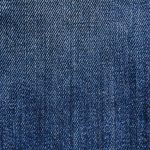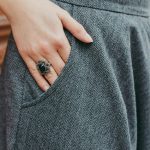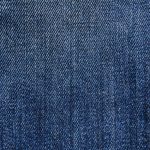You’ll spot herringbone fabric by its distinctive V-shaped zigzag weave that adds a unique textured look and feel. It’s crafted from materials like wool or cotton blends, giving a soft yet durable fabric that resists stretching and holds shape well. Thanks to its tight, reversed twill pattern, it’s stronger and hides wear better than plain weaves. If you want to know how this classic fabric fits into fashion and care routines, there’s more to explore.
Table of Contents
Key Takeaways
- Herringbone fabric features a distinctive V-shaped zigzag weave pattern, creating visual interest and a unique texture compared to plain twill.
- The fabric combines softness and subtle raised texture, offering a tactile feel that balances comfort with structured design.
- Common materials include wool, cotton blends, and synthetics, chosen for warmth, breathability, durability, and wrinkle resistance.
- Its zigzag weave enhances strength and shape retention, making herringbone fabric resilient and long-lasting with proper care.
- Widely used in tailored clothing and home decor, herringbone hides wear effectively and provides a refined alternative to traditional twill.
Understanding the Herringbone Weave Pattern
Although you might recognize the herringbone pattern from clothing or home decor, understanding how its weave works can deepen your appreciation.
The herringbone weave consists of columns of parallel lines arranged in a V shape, creating a zigzag pattern that resembles a fish skeleton. This effect happens because the direction of the twill weave reverses at regular intervals, producing alternating diagonal lines.
When you look closely, you’ll see that the fabric’s structure isn’t just decorative—it strengthens the material by distributing tension evenly. This pattern also helps prevent the fabric from stretching out of shape.
The Unique Texture of Herringbone Fabric
You’ll notice the herringbone fabric’s distinctive V-shaped pattern right away, created by its alternating raised and flat threads.
This interplay gives the fabric a soft yet textured feel that stands out from smoother weaves.
Once you touch it, you’ll appreciate how the texture adds depth without sacrificing comfort.
Distinctive V-Shaped Pattern
The distinctive V-shaped pattern sets herringbone fabric apart from other weaves, giving it a unique texture that catches your eye. This pattern resembles the bones of a herring fish, creating a zigzag effect that adds depth and sophistication. When you touch herringbone, you’ll notice the alternating direction of the weave, making the fabric visually dynamic.
| Feature | Description |
|---|---|
| Pattern Shape | V-shaped zigzag |
| Visual Effect | Creates depth and texture |
| Common Uses | Suits jackets, suits, and upholstery |
This pattern doesn’t just look good—it also helps the fabric maintain structure, making it a popular choice for both fashion and home decor. You’ll appreciate the subtle elegance herringbone brings to any item.
Raised and Flat Threads
Beyond its striking V-shaped pattern, herringbone fabric stands out because of the interplay between raised and flat threads. This unique texture gives the fabric depth and character, making it visually appealing and tactilely interesting.
When you examine herringbone closely, you’ll notice:
- Raised threads create subtle ridges, adding dimension to the weave.
- Flat threads lie smoothly between the ridges, balancing the texture.
- The alternating thread heights enhance light reflection, emphasizing the pattern.
This combination not only defines herringbone’s aesthetic but also contributes to its structural integrity.
You’ll find that the raised and flat threads work together to form a fabric that’s both distinctive and durable, setting herringbone apart from other weaves with more uniform textures.
Soft Yet Textured Feel
Herringbone fabric combines softness with a distinct texture that invites you to touch and feel its surface. You’ll notice a gentle, smooth base enhanced by the subtle zigzag pattern, giving it a tactile dimension unlike flat weaves.
This combination means you get comfort without sacrificing character—perfect for garments or upholstery that need both coziness and visual interest. As you run your fingers over the fabric, the raised diagonal lines create a delicate contrast against the softer background, making the texture both noticeable and pleasant.
This unique feel sets herringbone apart, ensuring it’s never dull or plain. You’ll appreciate how it balances softness with a structured pattern, providing a refined yet inviting touch every time.
Materials Commonly Used in Herringbone Fabrics
You’ll find herringbone fabric made from various materials, each adding its own feel and durability.
Wool varieties offer warmth and texture, while cotton blends provide softness and breathability.
Synthetic fibers are also common, boosting strength and wrinkle resistance.
Wool Varieties
Although wool comes in many varieties, certain types stand out for their suitability in herringbone fabrics due to their texture, durability, and appearance.
When choosing wool for herringbone, you want fibers that hold the distinctive zigzag pattern well and age gracefully. Here are three common wool varieties used:
- Merino Wool – Known for its fine, soft fibers, Merino offers a smooth texture and excellent breathability, making your herringbone fabric comfortable and stylish.
- Tweed Wool – This coarse, durable wool adds a rustic charm and rugged durability, perfect for outerwear or heavier garments.
- Romney Wool – With its medium coarseness and natural luster, Romney wool balances durability and softness, giving herringbone fabrics a classic look with good resilience.
Choosing the right wool guarantees your herringbone fabric looks great and lasts long.
Cotton Blends
Many fabric makers turn to cotton blends to combine comfort with durability in herringbone patterns.
When you choose cotton blended with fibers like polyester or linen, you get a fabric that feels soft against your skin but stands up to everyday wear.
Cotton’s breathability keeps you comfortable, while the added fibers enhance strength and reduce wrinkles.
This balance makes cotton blends ideal for casual and formal wear, offering versatility you’ll appreciate.
Plus, the herringbone weave adds a subtle texture that highlights the blend’s qualities, giving your garment a classic yet modern look.
Synthetic Fibers
Cotton blends offer a great mix of comfort and durability, but synthetic fibers bring another layer of benefits to herringbone fabrics.
When you choose synthetic fibers like polyester, nylon, or acrylic, you get enhanced strength and wrinkle resistance, making your fabric easier to care for.
Here’s why synthetic fibers stand out:
- Polyester: Adds durability and resists shrinking, keeping your herringbone fabric looking sharp.
- Nylon: Boosts abrasion resistance, perfect for high-wear items.
- Acrylic: Mimics wool’s warmth and softness but dries faster and resists moth damage.
Durability Factors of Herringbone Fabric
When you choose herringbone fabric, you’re investing in a material known for its strength and resilience. The distinctive zigzag weave pattern not only adds visual appeal but also reinforces the fabric’s structure, making it less prone to wear and tear.
You’ll find that the tight weave helps resist stretching and maintains its shape over time. Additionally, the durability depends on the fiber content; natural fibers like wool offer warmth and toughness, while blends with synthetic fibers can boost abrasion resistance.
Proper finishing techniques also enhance the fabric’s longevity by reducing pilling and fuzziness. When cared for correctly, herringbone fabric withstands frequent use and maintains its integrity, ensuring you get lasting quality in whatever you use it for.
Applications of Herringbone Fabric in Fashion and Home Decor
The durability and unique texture of herringbone fabric make it a popular choice across various fashion and home decor items.
Herringbone fabric’s durability and unique texture make it a stylish and practical choice for fashion and decor.
When you choose herringbone, you’re picking versatility and style. Here are three common applications:
- Fashion: You’ll find herringbone in tailored suits, jackets, and coats, where its distinctive pattern adds sophistication and durability.
- Accessories: Scarves, hats, and bags crafted from herringbone stand out due to the fabric’s textured weave and resilience.
- Home Decor: Throws, cushions, and upholstery benefit from herringbone’s strength and visual appeal, giving rooms a cozy yet refined look.
Comparing Herringbone With Other Twill Weaves
How does herringbone stand out compared to other twill weaves? Unlike the traditional diagonal pattern you see in standard twills, herringbone features a distinctive V-shaped zigzag design. This unique pattern not only adds visual interest but also creates a subtle texture that you won’t find in plain twill fabrics.
While both herringbone and other twill weaves share durability and flexibility, herringbone’s broken pattern helps hide wear and stains more effectively. If you want something classic yet different, herringbone offers a refined look that’s less common than the basic diagonal twill.
Care and Maintenance Tips for Herringbone Fabric
Although herringbone fabric is known for its durability, you’ll still want to handle it with care to maintain its distinctive pattern and texture.
Proper care guarantees your fabric stays vibrant and strong over time without losing its unique weave.
Here are three essential tips to keep your herringbone fabric looking its best:
- Gentle Washing: Use cold water and a mild detergent. Avoid harsh chemicals and bleach to prevent damage.
- Air Dry: Skip the dryer. Lay your fabric flat or hang it to air dry, preserving the weave’s integrity.
- Regular Brushing: Use a soft brush to remove dirt and dust, which can wear down fibers and dull the pattern.
Follow these steps, and your herringbone fabric will stay crisp, clean, and long-lasting.
Frequently Asked Questions
Can Herringbone Fabric Be Used for Upholstery Projects?
Sure, you can certainly use sturdy herringbone fabric for upholstery projects. Its strong structure supports sofas and seats, while subtle patterns provide a stylish, sophisticated surface that stands up to daily use without sacrificing charm or comfort.
Is Herringbone Fabric Suitable for Allergy Sufferers?
You might find herringbone fabric suitable if you’re allergy-prone, since it’s tightly woven and can resist dust mites. But make sure it’s made from hypoallergenic fibers and clean it regularly to avoid triggering allergies.
How Does Herringbone Fabric Perform in Different Climates?
You’ll find herringbone fabric adapts well to various climates; it keeps you warm in colder weather but can be breathable in milder conditions. Just pick the right fiber blend to suit your environment perfectly.
Are There Eco-Friendly Options for Herringbone Fabric?
Oh sure, because nothing screams eco-friendly like a fabric named after fish bones! But seriously, you can find herringbone made from organic cotton, recycled wool, or bamboo blends—so you can look sharp and save the planet simultaneously.
What Is the Historical Origin of the Herringbone Pattern?
You’ll find that the herringbone pattern dates back to ancient Roman times, where it was used in road paving. Its distinctive zigzag design mimics fish bones, giving the pattern its name and timeless appeal.
- Does Chiffon Fabric Stink - July 15, 2025
- Does Chiffon Fabric Affect the Economy - July 15, 2025
- Does Cotton Fabric Have a Nap - July 15, 2025







